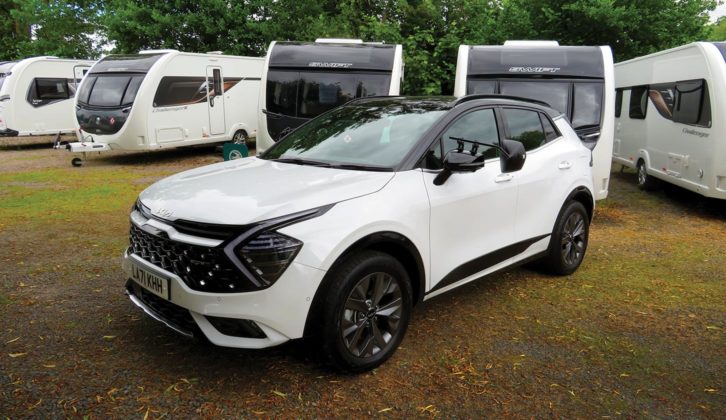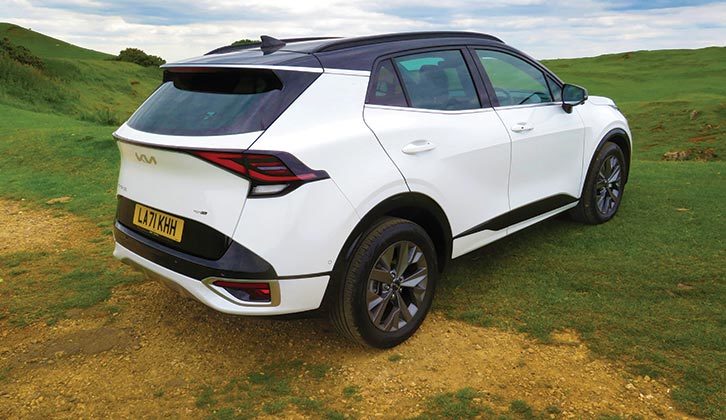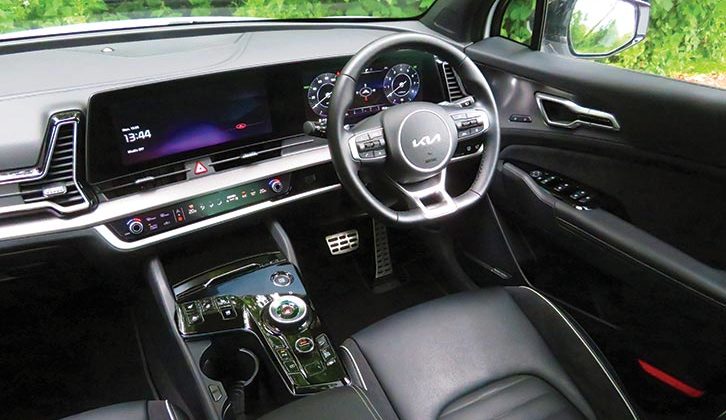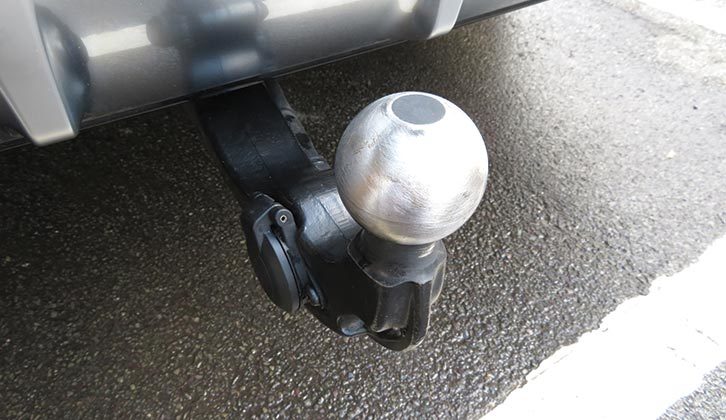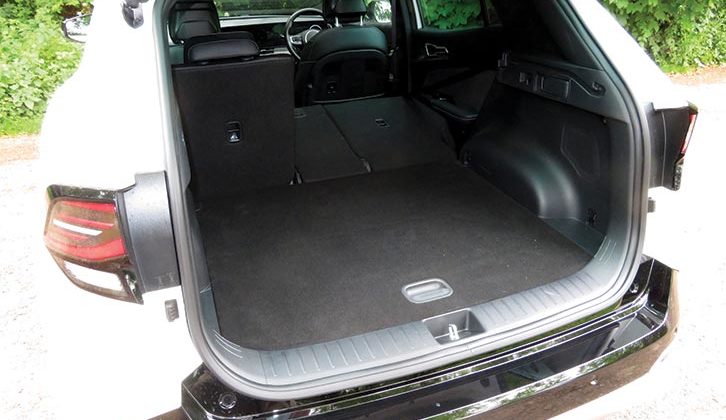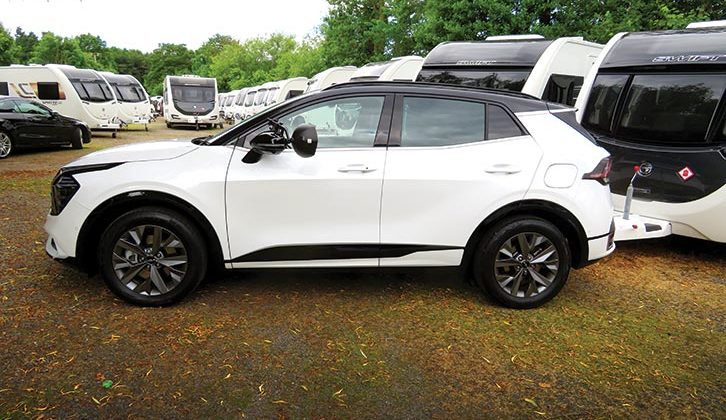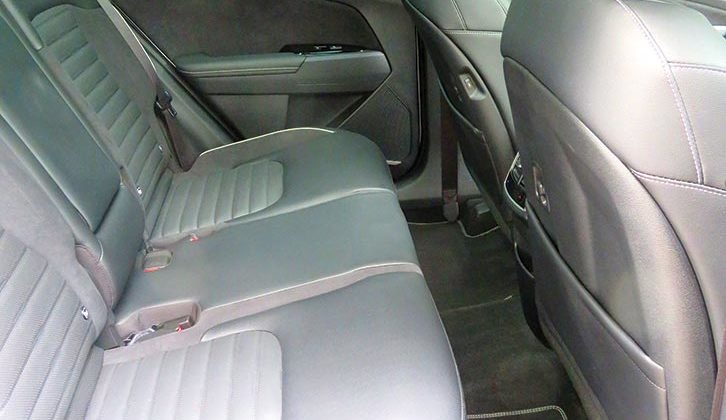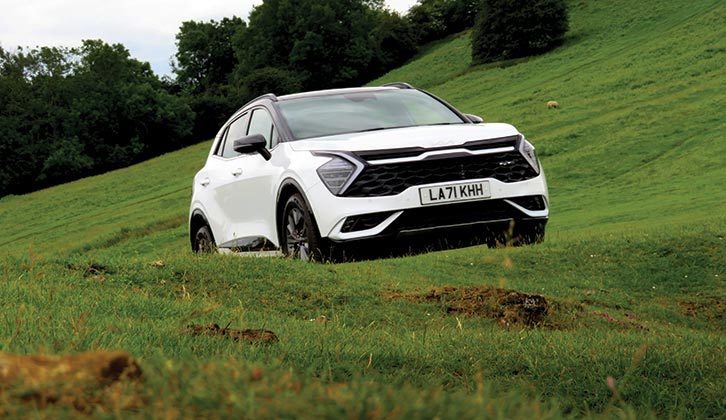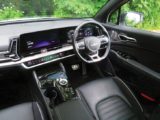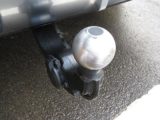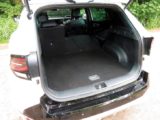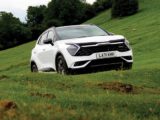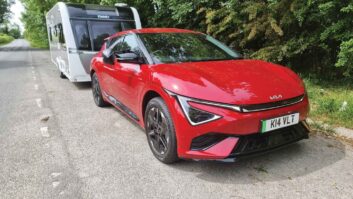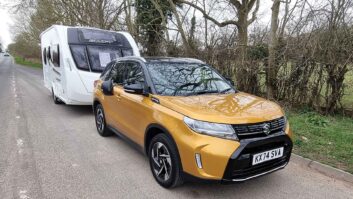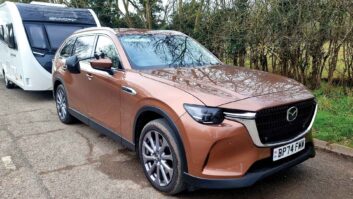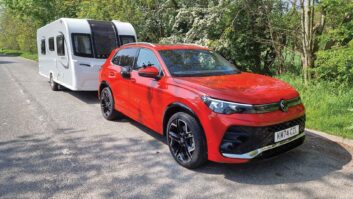This is the fifth generation of the Kia Sportage. Longer, taller and wider than the old model, the new Sportage promises customers more space, lots of high-tech driver aids, and a broad choice of engines – including diesel.
Unlike many new models, the Sportage is still available with diesel power, although more buyers are expected to opt instead for the mild, full, or plug-in hybrids.
There’s also a choice between front- and four-wheel-drive versions. We’re testing the full-hybrid 4×4 Sportage in GT-Line S spec, the Kia Sportage 1.6 T-GDI HEV AWD GT-Line S Auto.
What are we looking for?
The Sportage is one of the most popular tow cars in Britain, so this is one of the most significant tow tests of 2022. How well does the fifth generation tow, and is the full hybrid the sweet spot in the range?
Towing ability
The new Sportage weighs as little as 1526kg if you choose the 2WD petrol, or as much as 1905kg if you go for the plug-in hybrid. But while the plug-in model is by far the heaviest in the range, it has a modest 1350kg towing limit.
So if you’d prefer a broader choice of legal matches, the regular hybrid is a better bet. In 4×4 guise it provides a kerbweight of 1715kg and a legal towing limit of 1650kg.
We matched the Kia Sportage 1.6 T-GDI HEV AWD GT-Line S Auto to a Swift Challenger 530 with a MiRO of 1394kg.
The Kia quickly towed it up to speed. With 226bhp and 258lb ft of torque, it has enough muscle to cope with any sensibly matched caravan. You really notice the instant shove from the electric motor when pulling away.
Out on the open road, the six-speed automatic gearbox sometimes held onto high revs for what seemed an unnecessarily long time. This did make for noisy progress on country roads, especially when towing uphill or accelerating. However, engine noise settled down once humming along at a steady 60mph on the motorway.
In most conditions, the Kia is stable, but we could sometimes feel a bit of pushing and shoving from the caravan on bumpy country roads. It wasn’t immune to crosswinds, but movements were slight and rarely needed steering correction.
Hill starts are a doddle. The electric motor does a lot of the work at first, and in the dry there was no wheelspin pulling away on a 1-in-10 slope.
Towing a van on a warm summer day, the two-wheel-drive version of the Sportage hybrid would probably have coped just as well, but we’re pleased Kia also offers this powertrain with four-wheel drive.
Not only will it be a plus for wet-weather hill starts, it also increases the kerbweight by 66kg for more favourable matching ratios. It adds £1600 to the Kia’s price, but for all-year towing, that’s money well spent.
Arrive at your campsite (see our guide to the best caravan parks for inspiration) and you’ll find the Sportage easy to control at low speeds, although thick pillars do compromise the view over your shoulder. A 360-degree camera system is fitted as standard on GT-Line S cars, and the rear-facing camera is very helpful when hitching up.
The towball and electrics drop into place at the push of a button just inside the car’s tailgate, and retract back out of sight when not needed. Unlike similar towing gear on some rivals, the towbar locks into place without needing to be moved the last few centimetres by hand. The electric socket is on the side of the towbar, where it’s easy to access and well clear of the bumper.
All told, the Sportage is a very capable tow car. A little less engine noise and a slightly more secure feel in crosswinds would make it even better.
Solo driving
If you’re new to hybrids, the full-hybrid Sportage makes it very easy to consider switching. There’s no need to plug it in, as the car recharges the battery using energy that would otherwise be lost while slowing down or braking.
The disadvantage compared with the plug-in hybrid is that you won’t go far on electricity alone. The full hybrid has a 1.49kWh battery, while the plug-in has a capacity almost 10 times as big, at 13.8kWh. So in the full hybrid, you’ll creep through traffic or drive under light loads using the battery and electric motor, rather than completing your commute emissions-free.
Around town the powertrain is shown in its best light, with low average speeds and lots of stopping and starting to keep the battery level healthy. In these conditions the car is smooth, quiet and economical.
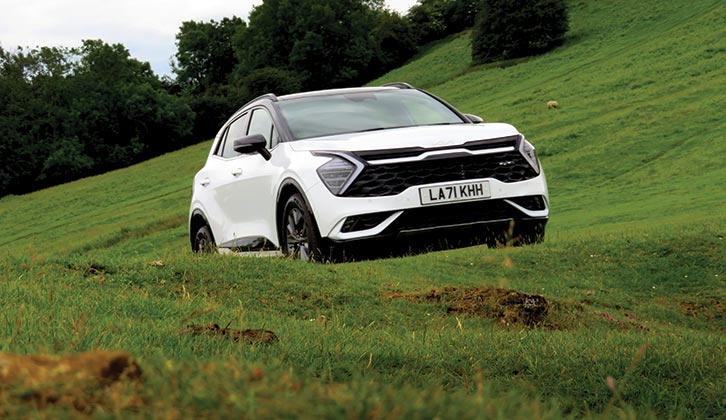
Head beyond the city and there’s a healthy turn of speed, with Kia quoting 0-60mph in 7.7 seconds – a couple of tenths quicker than the more powerful plug-in hybrid because of the weight difference between the two.
That said, if you make the most of the Kia’s performance, there’s a lot of engine noise, and the 1.6-litre petrol sounds strained at high revs.
On twisty roads the Kia handles neatly, but it’s not as engaging as a Mazda CX-5 or Seat Ateca. Switching the car to Sport setting adds some weight to the steering and sharpens the throttle, but given the choice on an empty B-road, we’d still reach for the Seat’s keys.
The ride is firm, although colleagues who have driven Sportages with smaller wheels than the 19-inch alloys on the GT-Line S say they are more forgiving of poor road surfaces.
On the motorway, the ride is composed, and wind and road noise aren’t excessive.
Space and practicality
Kia has stretched the Sportage a few millimetres in all directions and put that to good use inside.
Despite losing headroom to the sunroof, there was enough space for a 6’ 3” driver to get comfortable behind the wheel, and sufficient adjustment to accommodate folk of most shapes and sizes.
By SUV standards, you sit relatively low to the floor, but we had no complaints after a long day at the wheel. Electrically adjustable lumbar support is standard, which is welcome.
The cockpit is fully digital, with a screen in place of dials. You can change the layout depending on what you want to view. The touchscreen is clear and straightforward to use, and it’s always pleasing to see air conditioning controls separate from screen menus.
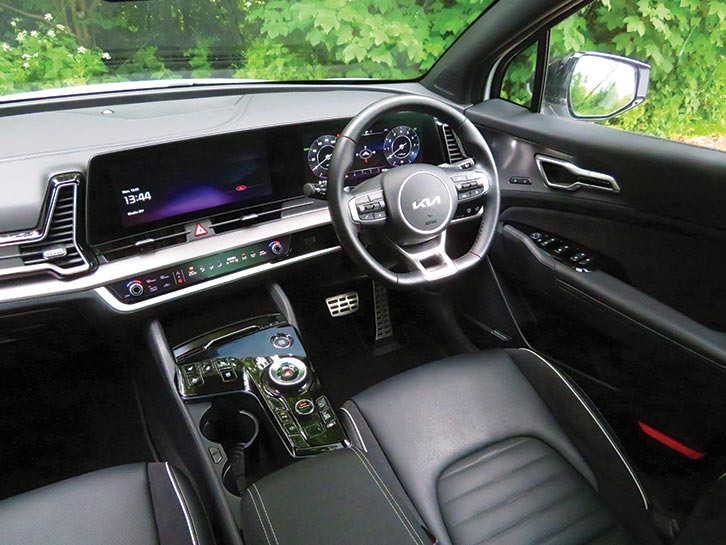
The back seats have enough space for adults, and there are air vents between the front seats. Kia has remembered that passengers will have phones and devices to charge, with USB ports built into the front seats.
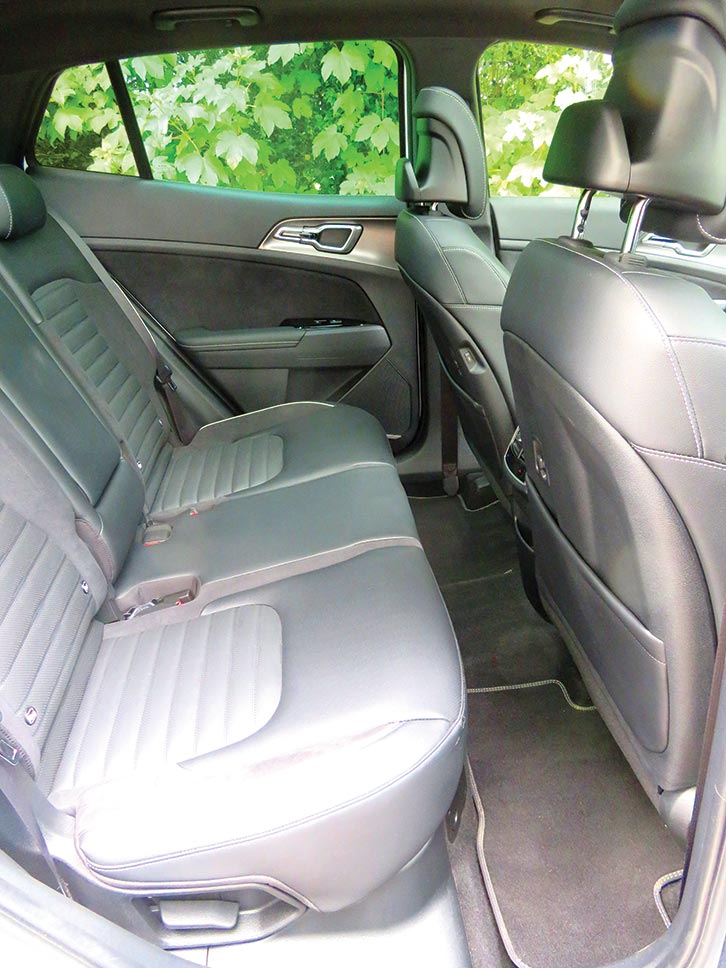
Sometimes hybrid versions have less boot space than their conventionally powered counterparts, but the Sportage’s luggage capacity is almost identical. We can’t see many owners feeling short-changed with 587 litres for bags, which is more than you’ll find in some estate cars.
There are levers either side of the tailgate to drop the seat backs. With all three sections of the 40/20/40 split rear bench lowered, the boot capacity increases to 1776 litres.
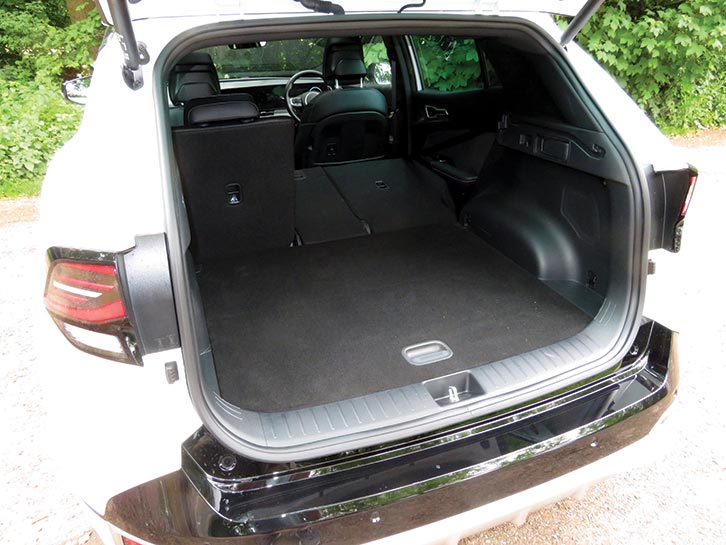
Buying and owning
With a price tag of £41,000, this high-spec Sportage nudges the price of the larger Sorento and very capable rivals, such as the Audi Q5. However, What Car?’s research suggests haggling will drop the price below £40,000.
It’s worth thinking about the more affordable models. The two-wheel drive in 3 spec costs £35,200. But if your pockets are deep enough for GT-Line S, you get a lot of equipment for your money. Leather upholstery, a heated steering wheel, heated and ventilated front seats, heated outer rear seats, wireless phone charging and a Harman Kardon stereo are standard.
Euro NCAP has awarded the Sportage five stars for safety, and it comes with autonomous emergency braking and a host of driver aids. Fuel bills should be reasonably affordable.
The Sportage has an official combined figure of 44.1mpg. We saw 42.3mpg on a long motorway drive, and 25.5mpg while towing a caravan.
After three years and 36,000 miles, the Kia should hang on to a respectable 51% of the original asking price.
Verdict
The new Sportage is a very capable machine, and the full hybrid model can lay claim to being the pick of the range for towing. We’d be surprised if one of the diesels didn’t prove more economical with a caravan behind it, but otherwise the hybrid tow car pulls very well.
With the electric motor and petrol engine working together, the Kia Sportage tows a caravan with ease, quickly reaching 60mph. It’s a bit of a shame the petrol engine isn’t smoother and quieter, but there’s no arguing with the vehicle’s performance.
For the most part, the Kia is also very stable, a trait of the best tow cars. The car did move around a little in a brisk crosswind, but there was nothing to cause any nervous moments. Hill starts are very easy, and we’re pleased Kia makes this model available with both two- and four-wheel drive. For anyone who tows their van all year round, the four-wheel-drive version has to be worth the extra.
In everyday driving, the Kia is easy to live with. It’s neither the most exciting nor the most comfortable family SUV, but it strikes a compromise that should suit most drivers. It’s well suited to urban driving, with the ability to creep through town traffic in near silence.
The cabin is solidly made and spacious, and the infotainment system is right up to the minute. There’s more space in the new car than the old model, and lots of room for the whole family’s holiday luggage.
In GT-Line S specification the Kia Sportage 1.6 T-GDI HEV AWD GT-Line S Auto is quite pricey, but you do get a very long list of standard equipment.
- Interested in finding out about a more lightweight Kia? Then take a look at our best small tow car round-up, which features the Kia Stonic
Key spec
- Price: £41,000
- What Car? Target Price: £39,173
- Retained value after three years: 51%
- Kerbweight: 1715kg
- 85% of kerbweight: 1458kg
- Gross vehicle weight: 2245kg
- Max towing limit: 1650kg
- Gross train weight: 3895kg
- Towball limit: 100kg
- Price of towball and electrics: £781
- Boot size min/max: 587/1776 litres
- Payload: 530kg
- Test conditions: Dry
- Engine size: 1598cc
- Official combined economy: 44.1mpg
- Towing economy: 25.5mpg
- Power (bhp)/rpm: 226/5500
- Torque (lb ft)/rpm: 258/1500-4500
- CO2 emissions: 146g/km
- First year car tax: £220
- Second year car tax: £510
- Insurance group: 25E
Interested in a different Kia vehicle? See what I made of the Kia EV9 GT-Line 378bhp AWD when I put it to the test.
If you’ve enjoyed reading this article, why not get the latest news, reviews and features delivered direct to your door or inbox every month. Take advantage of our brilliant Practical Caravan magazine SUBSCRIBERS’ OFFER and SIGN UP TO OUR NEWSLETTER for regular weekly updates on all things caravan related.
Technical Specifications
| Engine Size | 1598 cc |
| Kerbweight | 1715 kg |
| 85% KW | 1458 kg |
| Towball Limit | 100 kg |
| Maximum Towing Limit | 1650 kg |
| Power | 226 bhp |
| Torque | 258 lb ft |
| Offical MPG | 44.1 mpg |
| Towing MPG | 25.5 mpg |
| CO₂ | 146 g/km |
